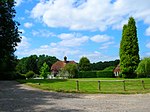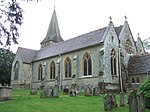Hollycombe Steam Collection
2 ft gauge railways in EnglandAmusement museums in the United KingdomMiniature railways in the United KingdomMuseums in West SussexRail transport in West Sussex ... and 4 more
Railway museums in EnglandSteam museums in EnglandUse British English from May 2017Woodland gardens

The Hollycombe Steam Collection is a collection of steam-powered vehicles, amusement rides, and attractions in South East England. It is based in West Sussex, but the closest town is Liphook in Hampshire. The collection includes fairground rides, a display farm, two railways, and the woodland gardens.
Excerpt from the Wikipedia article Hollycombe Steam Collection (License: CC BY-SA 3.0, Authors, Images).Hollycombe Steam Collection
Hollycombe Lane, Chichester
Geographical coordinates (GPS) Address Website External links Nearby Places Show on map
Geographical coordinates (GPS)
| Latitude | Longitude |
|---|---|
| N 51.0571 ° | E -0.7813 ° |
Address
Hollycombe Steam Collection
Hollycombe Lane
GU30 7LP Chichester
England, United Kingdom
Open on Google Maps







